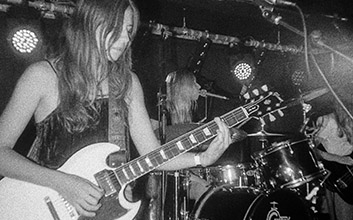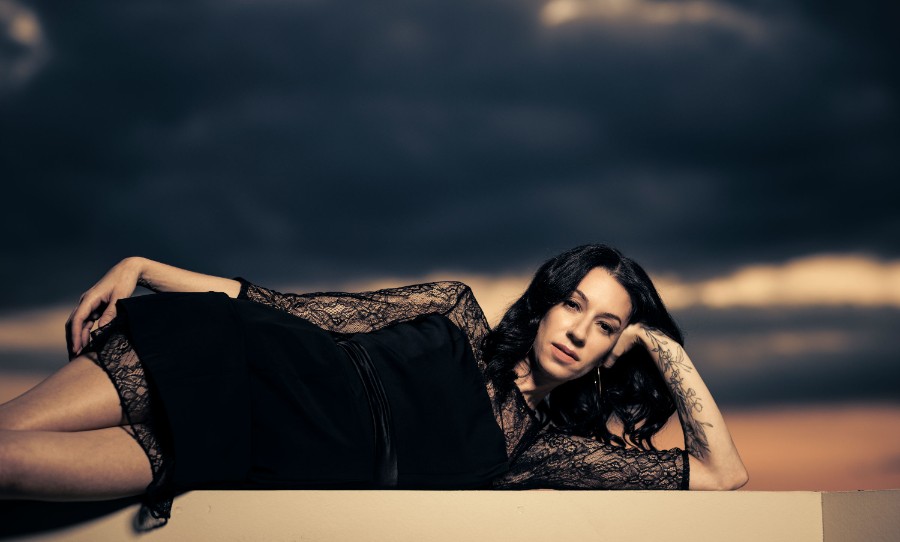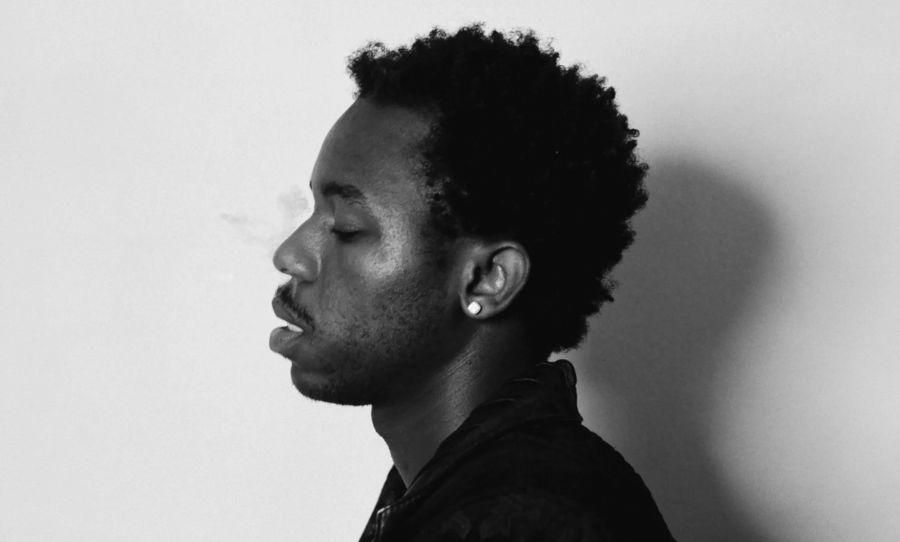Phillip Muzzall is not one to sit idly by while the world flashes past his eyes, bands play shows, and moments beg to be captured (and altered).
For a little over a year, the Wollongong-based photographer has been avidly shooting gigs around Sydney and his hometown, snapping the likes of King Gizzard & The Lizard Wizard, Ariel Pink, Kikagaku Moyo and Mild High Club, entirely on film. But his process doesn’t stop there.
We chat with photographer Phillip Muzzall about his bizarre techniques, the glory of film, and his obsession with psych music.
Muzzall shoots on a “quadrascopic” camera, which captures four images in quick succession. These are then processed digitally, fused into short GIF-like animations that convey a hypnotic sense of movement within each captured moment.
These shots quickly became an impressive collection of mesmerising vignettes portraying sweaty mosh pits and bands on stage, which culminated in an interactive zine called In Motion. Available both digitally and in print, the zine collates dozens of moments captured over the past 12 months. But again, his process didn’t stop there.
How does one get over the hurdle of presenting GIFs in an analog format? QR codes would be the answer (for Muzzall anyway).
As you flick or scroll through In Motion, you can view the images as they are – static – or you can whip out your phone, scan the QR code that accompanies each image with your camera, and watch the GIF on your screen. It’s a bold and fairly avante-garde project – hugely impressive from someone still at uni.
We caught up with Phillip to pick his brain about In Motion, how the project came together and where he learned these bizzare techniques. Before you read on, we definitely suggest checking out the zine online – it’ll blow your mind. You can also buy it here.
HAPPY: Hey Philip, how’s it going? What are you working on at the moment?
PHILLIP: I’m great thanks! Working a lot on uni assignments actually.
HAPPY: Heavy. What are you studying?
PHILLIP: A bachelor of media and communications with a major in digital media. In my second year of the course, really enjoying it.
HAPPY: Nice. Has your uni work fed much into your other creative pursuits?
PHILLIP: Definitely. It’s a good mix of creativity and theory. Everything seems to fit back and forth with my personal projects and the stuff I do at uni, especially the media art subjects because that’s pretty much where my zine came to fruition.
HAPPY: You dabble in so many different mediums – film and digital photography, video and GIFs, quasi-animation – what came first for you?
PHILLIP: A hundred percent video editing. I started when I was like around 10 or 11. I started to make really cringy videos as a child and upload them to Youtube, as I’m sure everyone did at least once. Then when I was around 13, like any other schoolboy, was really into video games and stuff and I started to edit games like Runescape. I got to the point where I wanted to start filming and do photography at 15, but video editing was still something I strived in better at the time. Eventually I migrated to editing Call of Duty clips and I still have a big following in that community today.
HAPPY: That seems pretty far removed from your more recent projects. When did you start shooting bands?
PHILLIP: I started shooting at gigs almost a year ago – early 2017. I was really inspired by other photographers like Dani Hansen and Jake Ollett that I was seeing on Instagram and film photography groups on Facebook. I just thought that seemed to be a better way to listen to the music and be creative at the same time with the artists performing. As well as sharing my perspective of the gigs that I was going to.
HAPPY: Oh rad. Dani is one of our photographers. She’s brilliant.
PHILLIP: Yes! She’s heaps nice and I love her work.
HAPPY: What did you start shooting on, film or digital?
PHILLIP: I started shooting on digital to learn on. I slowly crept up on film in 2015 when I picked up a roll and an SLR from a local sunday market. Since sending my first roll I haven’t really touched my digital camera other than to do some video work.
HAPPY: I feel like your style and the subject matter you shoot definitely lends itself more to the grittiness and volatility of film. Is this tied to your fascination with psych music? It seems like there’s a bit of a trend with your work, shooting bands like King Gizzard, Kikagaku Moyo, The Jim Mitchells…
PHILLIP: Yeah, I agree, I think it’s because of the nostalgic factor with film and when psych music emerged. Or maybe the look compliments sonic factors like lo-fi from psych and garage rock? Not sure, but it works! I got really into the psych scene when my friend Bree invited me to a King Gizz gig last minute at the Unibar at UOW two years ago. I knew of King Gizz but I wasn’t really into them until after the gig. It was so damn good. Since then I’ve gotten pretty into the scene I guess. There’s heaps more to explore out there, whether it’s online or at small venues, and that’s what I love about it.
HAPPY: And how did In Motion come into fruition?
PHILLIP: There were a couple of things that made it up. I had a zine planned with a friend from the States. His name is Magnus Holmes. But I wasn’t taking a lot of portraits, and that was the proposed concept. There was a media arts assignment where we were concentrating on computational media forms with instructions – so I thought the best way to present these animations was through instructing people to use their phones to read the QR code to see the animation. Turned out to be an interactive installation first off, then the zine idea pretty much came after.
HAPPY: So the animations came before the idea of a zine ever popped up? How did you develop that style? It’s so mesmerising.
PHILLIP: Yeah, I never thought of the concept at the beginning… just wondering where it would go and how far I can push the medium. I remember seeing the same animations using the same camera on Tumblr years ago, and I was really intrigued by it, but there wasn’t a lot of information on how to do it ‘till I came across it again. There were animations of models and the typical Tumblr art scene stuff. What I didn’t remember was people using it for other things like live music. Kind of surprising because it’s a bit of a powerful technique to capture a moment and for marketing or promotion purposes. I have to thank other gig photographers for the composition inspirations though.
HAPPY: Can you divulge a bit about the actual process? What are you shooting on and what’s involved in the post-production phase?
PHILLIP: Yeah sure. I use a Nishika N9000. There are a couple of other quad-lens “3D” film cameras alike, but the others are either too expensive, have stock issues or they vignette your images. I love using film that’s an ISO over 800 – just to play it safe as the camera is on fixed aperture. I send my rolls of film to Rewind in Glebe – they do a brilliant job! I get them back and I lightly edit each photo – one animation is comprised of four photos – in Lightroom and export to Photoshop to animate it to a six frame loop. I export it again as a video to take it into After Effects where I adjust the speed, tone down any flicker and do whatever I want to for the final video. It sounds like a lot, and there are probably shortcuts… but I’ve gotten into the habit of doing it the long way.
HAPPY: Such an awesome technique. How did you learn the ropes? You said there wasn’t much info out there on how to do it…
PHILLIP: A couple of years ago there wasn’t a lot of information because I saw it on Tumblr at first. But now there are tutorials on Youtube for it. There are flaws in them though. They don’t tell you how to edit them to make them look their best in After Effects. Like how to smooth them out like I did for Kikagaku Moyo, or to fix flickering and quality issues regarding uploading to socials.
HAPPY: Ahh right. Well you’ve definitely mastered it. It seems there’s this dichotomy in your work between digital and analog mediums – working online and with print, using film and digital techniques. Why is it you strive to split yourself between these two worlds?
PHILLIP: I really enjoy having physical mediums, like my obsession with vinyl. But it’s mostly the quality and aesthetic differences. You can fake grain and add filmic elements on your RAW image from your DSLR but I still don’t think you can beat the look of celluloid film. The quality is unbeatable, especially as scanning technology continues to improve. But I really don’t know why other than the aesthetic differences. I think the process is special. The movement of the photos from the physical space, to digital, then to people’s screens, and to people’s hands.
HAPPY: Absolutely. I read that you use a bunch of different film types too. What influences your choices?
PHILLIP: Money [laughs]. I recently finished a couple of rolls of black and white and I really enjoy the grungy look it’s rendering. But really, it helps to know the band’s look and music and pair it with the right emulsion. I guess it’s like tunneling a little bit of synesthesia. The black and white film works perfectly with the rough look and sound. Cinestill 800T is nice for the darker side of psych music and Fuji Natura 1600 is a balance.
HAPPY: I reckon presenting your work in zine format – both in print and digitally – is such a good way of making sure people take a moment to appreciate the idiosyncrasies of each photograph, especially so with the QR code element. Where did that idea come from?
PHILLIP: There’s a bunch of QR codes presented on posters on the ‘job, buy and sell’ boards in one of the buildings at my university. I guess the concept of the good old QR code crept up when I was trying to figure out how to print and present the animation for the installation.
HAPPY: Have you seen QR codes integrated into any, like, non-commercial creative mediums before? I can’t say I have really…
PHILLIP: Can’t say I have either!
HAPPY: Trailblazer.
PHILLIP: I kinda hope it does spark other people to do cross over technology and art stuff. Definitely needs to be explored.
HAPPY: For sure man. Who have been some of your favourite bands to shoot so far?
PHILLIP: Love shooting Rosa Maria. They were the first band that I shot at Freda’s. They’re brilliant performers and even better people.
HAPPY: Yeah they’re good dudes. Great band. Anyone you’re really keen to shoot moving forward?
PHILLIP: It’d be an absolute dream to do huge bands and artists like Radiohead, BadBadNotGood or Bjork. But I’m clearly not there yet… I’d love to shoot Party Dozen and GODTET. Hopefully I’ll get to their gigs during the uni break.
HAPPY: I reckon we could get you into a Radiohead gig.




